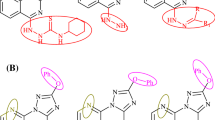Abstract
In this study, a series of 2,4-dichlorothiazolyl thiazolidine-2,4-dione (Ia-f) and 4-chloro-2-benzylsulfanylthiazolyl-thiazolidine-2,4-dione derivatives (IIa-f) were tested for their antioxidant properties by determining their effects on superoxide anion formation, and the 2,2-diphenyl-1-picrylhydrazyl (DPPH) stable free radical. Compound Ic showed the best superoxide anion scavenging activity at the 10−3 M and 10−4 M concentrations. The compounds (Ia-f and IIa-f) had the strong DPPH radical scavenger capacity at the 10−3 M concentration. Compound Ib, Id, and Ie showed similar activity to butylated hydroxytoluene (BHT) at 10−3 M and 10−4 M concentrations.
Similar content being viewed by others
References
Agarwal N, Kumar S, Srivastava AK, Sarkar PC (1997) Synthesis and biological evaluation of 2-amino-4-aryl-thiazole and their N-aroyl derivatives. Ind J Het Chem 6:291–294
Andreani A, Rambaldi M, Locatelli A, Leoni R, Bossa M, Chiericozzi I, Galatulas G, Salvatore A (1993) Synthesis of lactams with potential cardiotonic activity. Eur J Med Chem 28:825–829
Ayhan-Kılcıgil G, Kus C, Coban T, Can-Eke B, Iscan M (2004) Synthesis and antioxidant properties of novel benzimidazole derivatives. J Enz Inhib Med Chem 19(2):129–135
Becker EM, Nissen LR, Skibsted LH (2004) Antioxidant evaluation protocols: Food quality or health effects. Eur Food Res Technol 219(6):561–571
Blois MS (1958) Antioxidant determination by the use of stable free radical. Nature 181:1199–1200
Bozdağ-Dündar O, Ceylan-Ünlüsoy M, Verspohl EJ, Ertan R (2006), Synthesis and antidiabetic activity of novel 2,4-thiazolidinedione derivatives containing a thiazole ring. Arzneim.-Forsch/Drug Res 56 (9):621–625
Da Ros R, Assaloni R, Ceriello A (2004) The preventive anti-oxidant action of thiazolidinediones: a new therapeutic prospect in diabetes and insulin resistance. Diabet Med 21:1249–1252
El-Feky SAH (1993) Synthesis and anticonvulsant properties of some novel quinazolinone thiazolidine and 4-thiazolidone derivatives. Pharmazie 48:894–896
Frankel EN, Meyer AS (2000) The problems of using onedimensional methods to evaluate multifunctional food and biological antioxidants. J Sci Food Agric 80:1925–1941
Geronikaki A, Vicini P, Incerti M, Hadjipavlou-Litina D (2004) Thiazolyl and isothiazolyl azomethine derivatives with anti-inflammatory and antioxidant activities. Arzneim-Forsch/Drug Res 54 (9):530–537
Halliwell B (1999) Antioxidant defence mechanisms: from the beginning to the end (of the beginning). Free Radical Res 31:261–272
Hossain U, Bhattacharya S (2007) Synthesis of O-prenylated and O-geranylated derivatives of 5-benzylidene2,4-thiazolidinediones and evaluation of their free radical scavenging activity as well as effect on some phase II antioxidant/detoxifying enzymes. Bioorg Med Chem Lett 17(5):1149–1154
Lima MCA, Costa DLB, Goes AJS, Galdino SL, Pitta IR, Luu-Duc C (1992) Synthesès et activité antimicrobienne de dérivès chlorobenzyl benzylidène imidazolidinediones et thiazolidinediones substituées. Pharmazie 47:182–184
McCord J, Fridowich I (1969) An enzymic function for erythrocuprein (hemocuprein). J Biol Chem 243:6049–6055
Strumvoll M, Haring HU (2002) Glitazones: Clinical effects and molecular mechanisms. Ann Med 34:217–222
Unangst PC, Connor DT, Cetenko WA, Sorenson RJ, Sircar JC, Wright CD, Schrier DJ, Dyer RD (1993) Oxazole, thiazole, and imidazole derivatives of 2,6-di-tert-butylphenol as dual 5-lipoxygenase and cyclooxygenase inhibitors. Bioorg Med Chem Lett 3(8):1729–1734
Acknowledgement
This work was supported by Research Organization of Ankara University, Turkey (no. 2005-0803048)
Author information
Authors and Affiliations
Corresponding author
Rights and permissions
About this article
Cite this article
Bozdağ-Dündar, O., Çoban, T., Ceylan-Ünlüsoy, M. et al. Radical scavenging capacities of some thiazolylthiazolidine-2,4-dione derivatives. Med Chem Res 18, 1–7 (2009). https://doi.org/10.1007/s00044-007-9081-0
Received:
Accepted:
Published:
Issue Date:
DOI: https://doi.org/10.1007/s00044-007-9081-0




